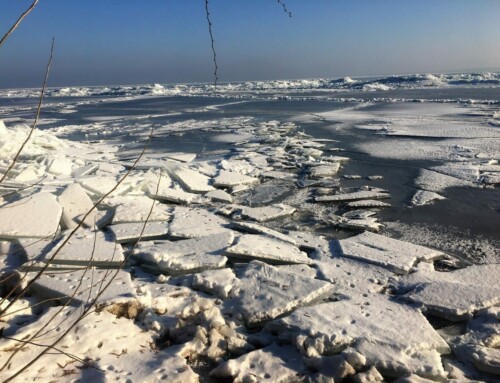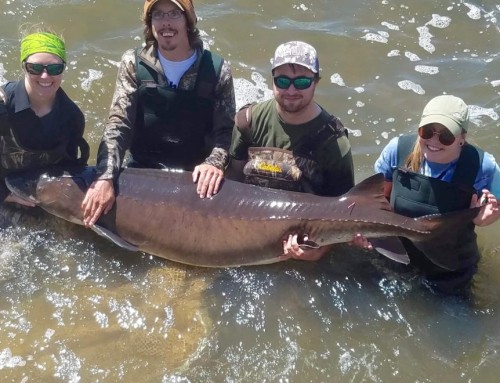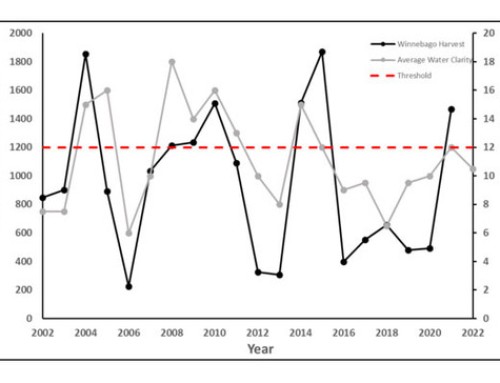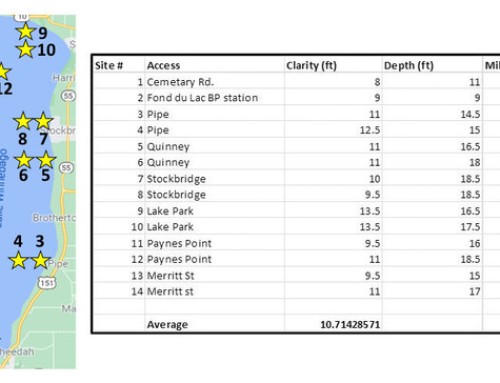Red Worms or Gizzard Shad: A Further Investigation of Sturgeon Diets If you have been at one of the 11 DNR sturgeon registration stations during the 2015 sturgeon spearing season you have likely heard the discussion about the leaner fish this year due to the lack of gizzard shad.
Note: If you would like to view the PDF with the photos and charts, please click this link instead Red Worms or Gizzard Shad_2015
This may have you wondering more about sturgeon foraging trends and research being conducted to monitor those trends. Well my colleagues and I within the fisheries program actually take a fairly holistic look at the availability of forage and relative importance of those forage items to sturgeon by conducting numerous surveys that each tell part of the story.
For starters, we monitor year class strength of game and non-game fish species within the Winnebago System through annual fall bottom trawl assessments. Of most importance to sturgeon is the strength of the gizzard shad hatch. Gizzard shad are not native to the Winnebago System, but have boom/bust year class cycles.
In boom years shad can be so abundant that they virtually saturate the food web (photo). However, shad experience large die offs during Wisconsin’s long, cold winters and sturgeon have adapted to opportunistically feed on dead or dying shad during this time. As shad are a much more fatty food source than the traditional aquatic insects that sturgeon normally predate on, sturgeon are able to increase their condition (fatten up) when shad are abundant.
Figure 1 demonstrates the boom/bust phenomenon of gizzard shad recruitment, while also showing that 2014 was a down shad year. Efforts have also been made to monitor the relative abundance of chironomid lake fly larvae (red worms).
The earliest surveys took place in the 1960s and efforts at that time were focused on determining ways to reduce lake fly abundance as the adults were viewed as a nuisance during summer emergence periods. In more recent times DNR crews have been working more intensively since the late 1990s to monitor trends in abundance. Similar to sturgeon spearers “worming” during scouting, this sampling involves dropping a dredge to the bottom to collect a mud sample that is then sieved for insects.
We have a fairly extensive data set from these sampling efforts and I hope to carve out some time to put together some reports from these data in the future. Gizzard shad captured from a single trawl transect on Lake Winnebago in 2010.
Diet analysis through collection of stomachs is an efficient method to assess foraging behaviors of sturgeon, but unfortunately it only provides a brief snapshot into overall foraging patterns in close proximity to when the stomachs are collected. Stable isotope testing, however, provides a long-term look by analyzing the delta carbon and delta nitrogen ratios in fish’s muscle tissue. If chemical signatures in prey sources differ significantly, then fish flesh can be tested to infer the relative contribution of these prey sources to the sturgeon’s muscle tissue. Stelzer et al. (2008) applied this technology to Winnebago System lake sturgeon and reported that although shad were an important prey source, lake fly larvae were still the more important forage item. I have attached a copy of the Stelzer et al. (2008) publication to this email, but I would also like to point out that we have collected muscle tissue samples from harvested fish in each year of 2013-2015.
The combination of stomach sampling and stable isotope analysis will continue to provide great insight into foraging behavior of our lake sturgeon. I hope you have found this report somewhat interesting and useful. As you can see we are collecting a great deal of information about forage availability and diet preferences of lake sturgeon in the system.
By monitoring these trends, we will be in a better position to effectively understand the factors affecting forage abundance and ultimately sturgeon condition. Stay tuned, I hope to expand on this report and go more in-depth on the importance of gizzard shad on fish condition and the number of 100+ pounders in recent spearing seasons!





